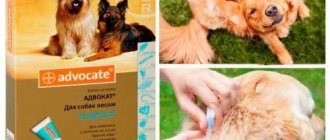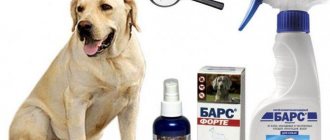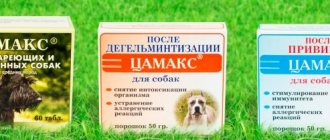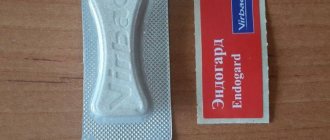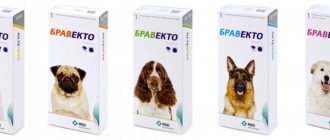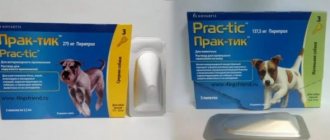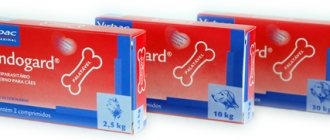Author:admin
How to use Enterosgel for dogs: dosage, indications, action
A healthy dog is full of energy, cheerful, playful and almost always happy with life, loves affection, enjoys the company of people, playing with the owner and going for a walk. However, a pet cannot, like a person, point with a finger “where it hurts” and explain “how it hurts.” For an attentive dog breeder, a natural habit is the ability to assess the health of his four-legged friend, to identify the slightest deviations in his appearance and behavior. If your dog loses his appetite, sleeps poorly, becomes apathetic, lethargic and restless, suffers from coughing, vomiting and loose stools, you should immediately address your pet’s health problems. If you notice such signs of illness in an animal (especially a puppy or small dog), you should immediately contact a veterinarian, and before seeing a doctor, give your pet first aid. First, you should cleanse your dog’s body of toxins using a sorbent. Is it possible to use the seemingly purely “human” Enterosgel for dogs? Yes. In veterinary practice, this remedy finds worthy use.
Description of the drug
Enterosgel is an enterosorbent based on organic silicon. The active substance is polymethylsiloxane polyhydrate. And this is the essence of a molecular sponge that is capable of absorbing toxic metabolic products, that is, adsorption occurs selectively. Enterosgel binds and removes from the body endogenous and exogenous toxic substances of various natures, including bacteria and bacterial toxins, antigens, food allergens, medications, poisons, heavy metal salts, and alcohol. In addition, the drug is able to absorb some of the metabolic products: excess urea, bilirubin, lipid complexes, cholesterol. Moreover, polymethylsiloxane polyhydrate is not absorbed into the systemic bloodstream and works only in the intestinal lumen. It does not undergo chemical or metabolic transformations and is excreted with the substances absorbed into it 12 hours after ingestion. This means that Enterosgel is harmless and non-toxic, and does not affect the absorption of vitamins and microelements.
Enterosgel is used for vomiting
Enterosgel has enterosorbing, antidiarrheal, enveloping, detoxification, and regenerating properties. The drug improves the functional state of the intestines, kidneys, liver, normalizes the functions of the immune and hematopoietic systems.
All this reduces the treatment time for most diseases.
For puppies and pregnant bitches
Before giving Enterosgel to a puppy or pregnant dog, you should consult a veterinarian. At this age and position, diarrhea is not always a symptom of poisoning.
Nausea and vomiting in babies may indicate overeating, and in the expectant mother - hormonal changes.
The doctor prescribes the dosage for pregnant dogs and puppies individually. The main condition is to give the drug separately from food, 1 hour after administration and 2 hours before the next feeding. Water is allowed to be drunk in unlimited quantities.
Indications
Enterosgel is often used in gastroenterology, allergology, nephrology, obstetrics and gynecology, pediatrics, and toxicology as a treatment for conditions in which intoxication of the body is observed. Thus, the indications for use of Enterosgel are:
- chronic kidney diseases (including pyelonephritis, glomerulonephritis, polycystic kidney disease, azotemia);
- burn disease in the intoxication phase;
- purulent-septic pathology, accompanied by significant intoxication of the body;
- toxicosis during pregnancy;
- allergic diseases (allergic rhinitis, bronchial asthma, food allergies, acute or chronic urticaria);
- skin diseases (atopic dermatitis, acne vulgaris, eczema);
- ARVI;
- radiation injuries;
- acute/chronic diarrhea of any nature (including viral, bacterial, occurring due to food poisoning or after treatment with antibiotics, associated with chronic inflammatory bowel diseases, malabsorption syndrome, etc.);
- poisoning with toxic and potent substances, including drugs, alcohol, salts of heavy metals;
- acute and chronic poisoning of the body, including food poisoning;
- intestinal syndrome caused by allergic food intolerance;
- acute intestinal infections of any origin (viral, bacterial infections)
- for toxic-infectious liver damage (including viral hepatitis types A and B, toxic hepatitis);
- with cholestasis of various origins;
- with cirrhosis of the liver;
- with hypo- or hyperacid gastritis;
- for peptic ulcer of the duodenum and stomach;
- with enterocolitis;
- with ulcerative colitis;
- with irritable bowel syndrome;
- with post-resection syndrome;
- during the periods before and after operations on the gastrointestinal tract.
For people who do not suffer from gastrointestinal problems to one degree or another, Enterosgel can be prescribed for the prevention of ischemic heart disease, atherosclerosis, for chronic intoxication in those employed in hazardous work, living in environmentally unfavorable regions, as well as for preventive cleansing of the body.
Causes of indigestion in dogs
Most often, diarrhea and vomiting in dogs occurs for the following reasons:
- Poisoning or allergic reaction. During walks, it is necessary to constantly monitor the dog, especially if it is prone to eating “delicacies” found on the street, which may turn out to be poisonous: they may well be planted by dog hunters. The toxic effect can also be caused by an overdose of drugs.
- Presence of intestinal parasites. If, when a large number of worms are found in a dog’s body, treatment is carried out only with deworming tablets, a side effect of the toxins of already dead parasites may occur and, as a result, poisoning. Therefore, after deworming, you should definitely use a sorbent.
- Some diseases of the digestive system. With gastritis and other gastrointestinal diseases (colitis, hepatitis, pancreatitis), lipid metabolism and intermediate purine metabolism are disrupted with an increase in the production of uric acid. As a result, the level of the latter in the body increases, which leads to intoxication.
- Diseases caused by certain infections (distemper, enteritis, rotavirus).
- Sudden change of food, overeating.
- Introducing vitamin and mineral complexes into the dog’s diet that are unsuitable for it.
Contraindications
Even though Enterosgel does not penetrate the systemic bloodstream and does not stick to the walls of the digestive canal, it has a number of contraindications:
- peptic ulcer of the duodenum or stomach in the acute stage;
- morphophysiological disorders in the gastrointestinal tract of various types (intestinal atony, acute gastric dilatation syndrome, etc.);
- hypersensitivity to Enterosgel components;
- bleeding from the gastrointestinal tract.
Side effects
Enterosgel is well tolerated, but this does not eliminate the possible occurrence of adverse reactions. Thus, taking the drug can cause nausea, periodic vomiting, and in the first days there is a possibility of developing constipation. In case of functional renal or liver failure, a feeling of aversion to the drug may occur.
Enterosgel is not a panacea, but an aid!
On the Internet you can find reviews from pet owners who talk about how, with the help of Enterosgel, they cured a dog or cat from enteritis, bloody diarrhea, rotavirus or even coronavirus infection (infamous to all cat breeders, FIP). Methodologically, this formulation of the question is not entirely correct. Enterosgel does not have antibacterial and antiviral activity, does not circulate in the animal’s blood and does not cleanse it of toxins. It works only in the lumen of the gastrointestinal tract. However, this work can be very effective and significantly increase the body's resistance to a sick pet. Freed from the need to neutralize toxins in the intestines and in the systemic bloodstream, the immune system directs all its forces to fight pathogens and has every chance of success. Unfortunately, in the case of FIP, which occurs in a malignant form with ascites and damage to all organs of the abdominal cavity, as a rule, neither Enterosgel nor other detoxicants help - the prognosis for this disease is still unfavorable. Fortunately, the deadly coronavirus is not transmitted to people and dogs.
Enterosgel is ineffective for acute poisoning with caustic liquids. If an animal accidentally swallows an acid or alkali, the chemical agent must be neutralized as quickly as possible - with baking soda or vinegar, respectively, and then urgently take the injured pet to the clinic for treatment of burns of the esophagus and stomach. The PH reaction of Enterosgel itself is neutral; it does not act on caustic media.
In the same way, the gel will not help with poisoning with potent agents - cyanide, rat poison (rodenticide), garden fertilizers, organic solvents, antifreeze, etc. Here, first of all, you need to induce vomiting and gastric lavage. The easiest way to induce vomiting in a pet is to pour a 3% solution of hydrogen peroxide into the mouth. The recommended dose is a teaspoon per 5 kg of animal weight, but in emergency cases it is usually not time to take measurements; the peroxide will still come out. The main thing is to cleanse the stomach as quickly as possible and save your pet from the most dangerous poison. Only later, when the bulk of the poison has been removed, the animal can be given Enterosgel.
How to take Enterosgel
Enterosgel in any dosage form is taken orally 2 hours before meals or medications, or 2 hours after.
Enterosgel paste is completely ready for use. It should be taken with enough water. But an aqueous suspension is made from Enterosgel in gel form before taking it. To do this, the required amount of gel is ground in a quarter glass of water, then taken with water.
Enterosgel paste is washed down with water.
Therapeutic course:
On average, the duration of the therapeutic course is 7-14 days. To prevent chronic intoxication, it is necessary to take 22.5 g (1 packet) 2 times a day for 7-10 days monthly. If the intoxication is pronounced, then the doctor may decide to double the dose in the first 3 days of therapy. After stabilization of the condition, they switch to the average therapeutic dosage. After the symptoms of acute intoxication or intestinal infection disappear, the drug is used for several more days.
For obstructive jaundice and liver cirrhosis, it may be prescribed for a longer period of time (2 months or more).
Repeating the course of treatment is permissible only after the recommendation of the attending physician.
Thus, the instructions for use of Enterosgel give the following dosages:
The daily dose (45 g for adults and 30 g for children) is divided into 3 doses. The duration of treatment is determined individually and depends on the severity of the disease and the age of the patient.
- single dosage – 1 tablespoon (15 g) – for adults;
- children under 3 years old – 1 teaspoon (5 g) 2 times a day (daily dose – 10 g);
- children 3-5 years old – 1 teaspoon 3 times a day (daily dose – 15 g);
- children 5-14 years old - 1 dessert spoon (10 g) 3 times a day (daily dose - 30 g).
Prevention:
For preventive purposes, adult patients are prescribed the following dosage regimen:
- prevention of ischemic heart disease and atherosclerosis - 1-1.5 months three times a day, 1 packet;
- prevention of chronic poisoning of the body - 7-10 days, twice a day, 1 packet;
- body cleansing - 10-14 days, three times a day, 1 packet (the cleansing course is repeated 3 to 6 times during the year).
For diarrhea:
You should immediately take 2 standard single doses of Enterosgel. In the future, the drug is taken 1 standard dose after each bowel movement. After the stool returns to normal, the drug is taken in an age-appropriate dosage for another 5 days.
It is important to remember that diarrhea cannot be treated with sorbent alone. It is necessary to find out the source of the disease and begin comprehensive drug treatment. After all, diarrhea can be infectious or non-infectious. A doctor can determine the cause of diarrhea.
When vomiting:
Enterosgel is taken when vomiting, as it usually indicates intoxication of the body. In case of acute poisoning, the dose of Enterosgel can be doubled for the first three days. After this, you should take the standard therapeutic dosage - 1 packet or 1.5 tbsp. spoons 3 times/day. On average, in case of poisoning, the therapeutic course lasts 10 days. The drug must be taken immediately after vomiting has stopped. If there is a series of attacks, then in the interval between them. It is worth noting that Enterosgel is contraindicated if the cause of poisoning is caustic substances (acids or alkalis), some solvents (for example, ethylene glycol or methanol), or cyanides.
Important! For diseases that are accompanied by fluid loss (vomiting, diarrhea), the use of Enterosgel should be supplemented with rehydration solutions that replenish the deficiency of electrolytes. This is necessary to avoid dehydration and subsequent complications. To replenish the volume of lost fluid and electrolytes, you should purchase specialized drugs at the pharmacy: Regidron, Trisol, Gidrovit, Reosolan, Gastrolit, Humana Electrolyte, etc.
Your doctor will help you choose the required dosage and frequency of administration.
Instructions for use of Enterosgel for diarrhea in dogs
Enterosgel should be given to a dog twice a day between meals, that is, either before or after meals, and the interval between taking the drug and feeding the dog should be at least two hours. As for the duration of treatment of dogs with Enterosgel, in case of acute poisoning the drug is given to dogs for five to seven days, in case of chronic intoxication - two to three weeks. The dose is selected individually by the veterinarian in each specific case. Typically, a large dog (over forty kilograms in weight) is given two teaspoons of gel for each dose for diarrhea; smaller dogs are given one teaspoon. Moreover, if a puppy suffers from diarrhea or vomiting, the dosage should be halved: for large breeds - one teaspoon, for small breeds - half a teaspoon. It is usually advised to squeeze the gel from the tube onto a spoon, stick the spoon deep into the mouth and pour in a little water from the syringe so that the dog swallows.
Some dogs enjoy eating the gel, especially if it is sweet. But sometimes pets begin to “be capricious” and refuse to eat Enterosgel, spitting it out, although usually it has no taste. Then the owners wonder how to give the drug to the obstinate. You can try feeding the medicine with cunning. Dilute the drug with water in a ratio of 1:3 and, using a medical syringe, inject it into the dog’s mouth without playing, and hold the muzzle for several seconds. The dog's swallowing reflex will work and the medicine will enter the body. In addition, you can dilute the gel in a cup and pour a spoonful into the dog’s mouth, and then give some kind of encouragement. In the case of a large dog, you can roll up lumps of Enterosgel and add them to some treat, or simply put them in the dog’s mouth and fill them with water from a syringe. After the procedure, the pet must be given water to drink: this will increase the detoxifying properties of the medicine and prevent dehydration.
Please note that the instructions for the drug Enterosgel prohibit its use if the dog is poisoned with poisons such as cyanides, caustic substances (acids and alkalis), organic solvents (methanol, ethylene glycol), since if the drug causes vomiting, the reverse movement of these substances through the esophagus The mucous membrane of the animal is re-injured. In addition, Enterosgel sorbent is contraindicated in dogs with complete intestinal obstruction, atony, peritonitis and perforation of the intestinal wall. In rare cases, animals may have individual intolerance to the components of the drug.
Still, poisoning and diarrhea in a beloved pet is easier to prevent than to treat. Prevention of diarrhea in dogs begins with the correct selection of special food or ensuring a smooth transition to a new diet. Even as a puppy, the dog needs to be taught to pick up scraps, garbage from the ground, and drink from puddles. After a walk, be sure to wash your dog's paws. Timely disposal of parasites (both intestinal and cutaneous) is the key to your pet’s health.
Along with this, you must always have a veterinary first aid kit “on alert” in your home. It must contain Enterosgel sorbent as a means of first aid for a pet with diarrhea and poisoning. The price of the drug is about four hundred rubles. Buy Enterosgel and rest assured about the health of your pet!
Enterosgel during pregnancy and lactation
The annotation for the drug states that taking Enterosgel during pregnancy and breastfeeding is not contraindicated. Thus, the drug is prescribed to reduce the severity of toxicosis, in case of fetoplacental insufficiency (placental dysfunction), for the treatment of acute and chronic bacterial, viral or fungal vaginal infections.
Enterosgel is not contraindicated during pregnancy
Restrictions
The medicine has virtually no contraindications for use, including for puppies and pregnant women, as well as lactating females. It is prohibited to use in case of atony or complete intestinal obstruction, peritonitis, or perforation of the intestinal wall.
There were no cases of overdose or allergies to the drug. After taking Enterosgel, in extremely rare cases, vomiting or constipation may occur. In this case, you should stop using the medicine and contact your veterinarian for another treatment.
Enterosgel for children
The drug is well tolerated and safe for children. The paste/gel (without sweetener) can be given to a child from birth.
The drug is absolutely harmless for children
For infants and toddlers, Enterosgel is mixed with three times the volume of liquid before use: water or breast milk. Older children can simply drink the paste/gel with water.
According to the instructions, the dosage of Enterosgel for children depends on age:
- from 0 to 12 months: 1.7 g (1/3 teaspoon) 6 times / day. The daily dose should not exceed 10 g;
- from 12 months to 5 years: 15-30 g/day. dividing the dose into 3 doses;
- after 5 years: gel/paste take 30-45 g/day, dividing the dose into 3 doses.
Dosage and duration of use
The dosage of Enterosgel for adult dogs is calculated based on the weight of the animal:
- a single serving for small pets (up to 5 kg) is 1 teaspoon;
- A medium-sized dog should take 2 teaspoons;
- representative of large and giant breeds - 2 tablespoons of the product.
Due to the absence of a strong taste and smell, pets themselves lick the gel from the spoon. If your pet is stubborn, dilute the drug with water in a ratio of 3:1, put it in a syringe, remove the needle and pour it into the animal’s mouth.
Enterosgel is given to a dog with diarrhea for 3-14 days, twice a day, until all symptoms of poisoning disappear.
Enterosgel and alcohol
The active ingredient of Enterosgel - polymethylsiloxane polyhydrate - effectively binds alcohol and its breakdown products located in the gastrointestinal tract, and also helps to reduce their concentration in the blood.
Taking the gel protects the liver and helps it recover quickly after alcohol poisoning.
For a hangover, to speed up the removal of alcohol from the body, take 3-4 tbsp. spoons of gel/paste immediately after drinking alcohol and the same dose in the morning.
To avoid a hangover, you should drink:
- 15 g after drinking alcohol;
- 15 g in the morning;
- 7.5 g per day (if hangover symptoms have not been completely eliminated).
Owner reviews
Anastasia: “One day, after a morning walk, our favorite dachshund began to vomit horribly: with foam and bile. She didn’t eat, didn’t drink, lay flat. They suspected that she had swallowed something and rushed to the clinic. The doctor diagnosed poisoning and told me to give Enterosgel. Fed a teaspoon three times a day, after diluting with water. The entire course took 400 grams of paste. Expensive, but the dog pulled through."
Yulia: “Our German Shepherd puppy, at one and a half months old, managed to steal the missing sour cream from the trash can. They immediately started giving him Enterosgel. I didn’t eat it myself, apparently the pasta disgusted me. I had to dilute it with water and inject it from a syringe. The lumps were first kneaded: this makes it easier to administer the drug. The medicine worked immediately, there was no constipation, digestion quickly improved.”
Zlata: “My Spitz ate some kind of poison on the street. Terrible vomiting began: vomiting several times an hour. As luck would have it, it was already Friday evening. We don’t have 24-hour veterinarians, and none of them are open on weekends. I remembered that Enterosgel was lying in the medicine cabinet. She diluted it in water and drank as much as she could pour into the poor fellow. By Monday the condition had returned to normal. The clinic said that if it weren’t for the paste, the dog would have died in two days.”
Enterosgel for allergies
As for the use of Enterosgel for allergies, monitoring of patients indicates a noticeable improvement in their condition. Thus, with bronchial asthma, the patient’s condition improves by the 3rd day of treatment, and after 2 weeks breathing returns to normal.
For allergies that are associated with disorders of the digestive system, the use of Enterosgel helps remove toxins from the body, restore intestinal function, and also helps prevent erosion. Improvements are observed already on the 4-5th day of using the drug.
Enterosgel for allergies
Enterosgel is used to treat eczema. It takes 6 days to eliminate fresh rashes.
Using the drug for the treatment of atopic dermatitis allows you to extend the period of remission to 8 months (usually remission lasts no more than six months).
conclusions
Enterosgel is an excellent absorbent. I regularly use it for poisoning, digestive problems due to infectious diseases or gastrointestinal pathologies.
Over many years of practice, not a single animal has developed an allergy. A common side effect is constipation. But it goes away with mild herbal laxatives and after normalizing the diet. The medication is convenient because animal owners can use it independently: there is no need to accurately calculate the dosage. In addition, the drug is sold in every pharmacy and is easy to obtain. It is ideal for urgent care when it is not possible to immediately get to a veterinary clinic.
If possible, I recommend replacing Enterosgel for dogs with the veterinary drug EnteroZoo. It costs a little more, but is designed specifically for animals, and the instructions contain exact dosages for dogs of different breeds.
Of the “human” analogues, Polysorb is the leader: it is inexpensive, fast and effective. But it is not as convenient to use as adsorbing gels.
You need to understand that diarrhea and vomiting are signs not only of poisoning, but also of many serious diseases. Therefore, any adsorbent medicine is used only as first aid to relieve acute symptoms. Afterwards, a visit to the hospital is required to confirm the diagnosis and clarify the treatment regimen.
Analogs
Enterosgel is a safe, universal in pharmacological properties and action, and a well-proven sorbent. However, cost or allergies to the components of the drug may force the patient to look for a cheaper but effective analogue.
The same pharmacological group with Enterosgel includes: Activated carbon, Diosmectite, Lactofiltrum, Lignosorb, Carbosorb, Microcel, Sorbex, Neosmectin, Polysorb MP, Polyphepan, Smecta, Filtrum-STI, Entegnin, Enterodes, Ultra-adsorb, Enterosorb, Enterumin, Enterosorbent SUMS -1.
Polysorb MP is the most common replacement for Enterosgel. It also adsorbs metabolic products and toxic substances, and also increases the ability to restore tissue. It is based on silicon dioxide. Polysorb, like Enterosgel, does not injure the mucous membrane of the digestive tract. Unlike Enterosgel, Polysorb is available only in powder form, which is used for external treatment of pustular skin diseases and wounds, as well as for preparing a suspension for oral administration. Its only side effect may be constipation. It is also contraindicated in patients with acute inflammatory processes in the gastrointestinal tract. In this case, Enterosgel can be used as prescribed by a doctor.
Remember that analogues may have similar properties and effects. But they have their own indications for use, daily dosage, and list of adverse reactions. That is why only a doctor can prescribe or replace one drug with another.
Release form
Enterosgel is produced in the form of a paste (hydrogel), packaged in tubes of 225 and 22.5 g. White or almost white in color, in two types - sweet and neutral taste. In structure, it is a molecular sponge of hydrophobic nature based on an organosilicon matrix, with increased sorption properties.
The jelly-like mass does not require preparation of a suspension and is immediately ready for use, which significantly reduces time. According to the observations of veterinarians and dog owners, sweet paste for oral administration is more readily consumed by pets.
Enterosgel is not available in powder and tablet forms, as is typical for other enterosorbents. However, as practice shows, it is thanks to the cross-linked matrix and cellular structure of the gel that the greatest effectiveness of the drug is achieved.
Storage conditions and shelf life
Enterosgel has a shelf life of 3 years.
Store the medicine at a temperature not lower than +4 degrees and not higher than +30 degrees, do not freeze. I recommend protecting the packaging from drying out after it is opened.
Under no circumstances use the medicine after the expiration date indicated on the package has expired.
Enterosgel has a shelf life of 3 years


